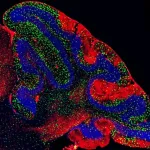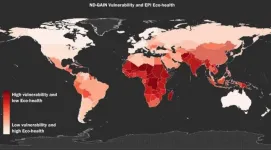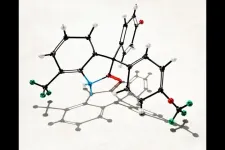(Press-News.org) Northwestern University researchers have developed a new framework using machine learning that improves the accuracy of interatomic potentials -- the guiding rules describing how atoms interact -- in new materials design. The findings could lead to more accurate predictions of how new materials transfer heat, deform, and fail at the atomic scale.
Designing new nanomaterials is an important aspect of developing next-generation devices used in electronics, sensors, energy harvesting and storage, optical detectors, and structural materials. To design these materials, researchers create interatomic potentials through atomistic modeling, a computational approach that predicts how these materials behave by accounting for their properties at the smallest level. The process to establish materials' interatomic potential -- called parameterization -- has required significant chemical and physical intuition, leading to less accurate prediction of new materials design.
The researchers' platform minimizes user intervention by employing multi-objective genetic algorithm optimization and statistical analysis techniques, and screens promising interatomic potentials and parameter sets.
"The computational algorithms we developed provide analysts with a methodology to assess and avoid traditional shortcomings," said Horacio Espinosa, James N. and Nancy J. Farley Professor in Manufacturing and Entrepreneurship and professor of mechanical engineering and (by courtesy) biomedical engineering and civil and environmental engineering, who led the research. "They also provide the means to tailor the parameterization to applications of interest."
The findings were published in a study titled "Parametrization of Interatomic Potentials for Accurate Large Deformation Pathways Using Multi-Objective Genetic Algorithms and Statistical Analyses: A Case Study on Two-Dimensional Materials" on July 21 in Nature Partner Journals - Computational Materials.
Xu Zhang and Hoang Nguyen, both students in Northwestern Engineering's Theoretical and Applied Mechanics (TAM) graduate program, were co-first authors of the study. Other co-authors included Jeffrey T. Paci of the University of Victoria, Canada, Subramanian Sankaranarayanan of Argonne National Laboratory, and Jose Mendoza of Michigan State University.
The researchers' framework uses training and screening datasets obtained from density functional theory simulation results, followed by an evaluation step that includes principal component analysis and correlation analysis.
"We defined a sequence of steps to reach an iterative learning approach given specific optimization objectives," said Espinosa, who directs the TAM program. "Our statistical approach enables users to realize conflicting optimization goals that are important in setting limits of applicability and transferability to the parametrized potentials." These relations can reveal underlying physics behind some phenomena that seem to be irrelevant to each other.
The team identified a positive correlation between the accuracy of interatomic potential and the complexity and number of the stated parameters -- a phenomenon believed to be true in the field, but previously unproven using quantitative methods. This level of complexity must be met by a commensurate amount of training data. Failure to do so, especially data carrying critical information, leads to reduced accuracy.
The researchers found, for example, that to improve the fidelity of interatomic potentials, non-equilibrium properties and force-matching data are required.
"This included a better description of large deformation pathways and failure in materials," Nguyen said.
"While these are not conventional properties that people target during parametrization, they are critical in understanding the reliability and functionality of materials and devices," Zhang said.
The new approach also helps remove the barrier of user experience to enter this research field. "Through this work, we hope to make a step forward by making the simulation techniques more accurately reflect the property of materials. That knowledge can be expanded upon and eventually impact the design of devices and technology we all use," Zhang said.
Next, the researchers will use their models to expand their investigation to study fracture and deformation in 2D materials, as well as the role of defect engineering in toughness enhancements. They are also developing in situ electron microscopy experiments that will reveal atomistic failure modes, providing a way to assess the predictive capabilities of the parameterized potentials.
INFORMATION:
The research was supported by the National Science Foundation (award number CMMI 1953806). Computational resources were provided by the Center of Nanoscale Materials at Argonne National Laboratory and the Quest High Performance Computing Cluster at Northwestern University. Use of the Center for Nanoscale Materials, an Office of Science user facility, was supported by Office of Basic Energy Sciences within the US Department of Energy's Office of Science (contract number DE-AC02-06CH11357).
In a recently published paper, a research team, led by University of Miami (UM) Rosenstiel School of Marine and Atmospheric Science Professor Emeritus Joseph M. Prospero, chronicles the history of African dust transport, including three independent "first" discoveries of African dust in the Caribbean Basin in the 1950s and 1960s.
Every year, mineral-rich dust from North Africa's Sahara Desert is lifted into the atmosphere by winds and carried on a 5,000-mile journey across the North Atlantic to the Americas. African dust contains iron, phosphorus and other important nutrients that are essential for life in marine and terrestrial ...
BROOKLYN, New York, Weekday, Month xx, 2021 - The remarkable structural properties of the Venus' flower basket sponge (E. aspergillum) might seem fathoms removed from human-engineered structures. However, insights into how the organism's latticework of holes and ridges influences the hydrodynamics of seawater in its vicinity could lead to advanced designs for buildings, bridges, marine vehicles and aircraft, and anything that must respond safely to forces imposed by the flow of air or water.
While past research has investigated the structure of the sponge, there have been few studies of the hydrodynamic fields surrounding and penetrating the organism, and whether, besides improving its mechanical ...
BROOKLYN, New York, Wednesday, July 21, 2021 - This week, at the 38th International Conference on Machine Learning (ICML 21), researchers at the END ...
Efforts to understand cardiac disease progression and develop therapeutic tissues that can repair the human heart are just a few areas of focus for the Feinberg research group at Carnegie Mellon University. The group's latest dynamic model, created in partnership with collaborators in the Netherlands, mimics physiologic loads on engineering heart muscle tissues, yielding an unprecedented view of how genetics and mechanical forces contribute to heart muscle function.
"Our lab has been working for a long time on engineering and building human heart muscle tissue, so we can better ...
UT Southwestern researchers have identified an immune protein tied to the rare neurodegenerative condition known as Niemann-Pick disease type C. The END ...
For more than 30 years, scientists on the U.N.'s Intergovernmental Panel on Climate Change have focused on human-induced climate change. Their fifth assessment report led to the Paris Agreement in 2015 and, shortly after, a special report on the danger of global warming exceeding 1.5 degrees Celsius above pre-industrial levels. The Nobel Prize-winning team stressed that mitigating global warming "would make it markedly easier to achieve many aspects of sustainable development, with greater potential to eradicate poverty and reduce inequalities."
In a first-of-its-kind study that combines assessments of the risks of toxic emissions (e.g., fine particulate matter), ...
COLUMBUS, Ohio - Exoskeletons - wearable devices used by workers on assembly lines or in warehouses to alleviate stress on their lower backs - may compete with valuable resources in the brain while people work, canceling out the physical benefits of wearing them, a new study suggests.
The study, published recently in the journal Applied Ergonomics, found that when people wore exoskeletons while performing tasks that required them to think about their actions, their brains worked overtime and their bodies competed with the exoskeletons rather than working in harmony with them. The study indicates that exoskeletons may place enough burden on the brain that potential benefits to the body are negated.
"It's almost like dancing with a really bad partner," said ...
CHAMPAIGN, Ill. -- A new approach to treating breast cancer kills 95-100% of cancer cells in mouse models of human estrogen-receptor-positive breast cancers and their metastases in bone, brain, liver and lungs. The newly developed drug, called ErSO, quickly shrinks even large tumors to undetectable levels.
Led by scientists at the University of Illinois Urbana-Champaign, the research team reports the findings in the journal Science Translational Medicine.
"Even when a few breast cancer cells do survive, enabling tumors to regrow over several months, the tumors that regrow remain completely ...
Unlike the rest of the body, there is not enough real estate in the brain for stored energy. Instead, the brain relies on the hundreds of miles of blood vessels within it to supply fresh energy via the blood. Yet, how the brain expresses a need for more energy during increased activity and then directs its blood supply to specific hot spots was, until now, poorly understood.
Now, University of Maryland School of Medicine and University of Vermont researchers have shown how the brain communicates to blood vessels when in need of energy, and how these blood vessels respond by relaxing or constricting to direct blood flow to specific brain regions.
In their new paper, published on July 21 in Science Advances, ...
Every year, Santa Ana Winds drive some of the largest wildfires in Southern California during autumn and winter, and a new analysis of 71 years of data suggests that the total amount of land burned is determined more by wind speed and power line ignitions than by temperature and precipitation. The findings suggest that maintaining utility lines and carefully planning urban growth to reduce powerline ignitions may help to reduce future losses from Santa Ana-driven autumn and winter fires, which occur far less frequently than summer fires but account for the largest blazes annually. While California's summer fires are typically driven by an abundance of fuels such as dry twigs and logs, and are often ignited by lightning in remote areas, the state's autumn and winter fires are typically ...



